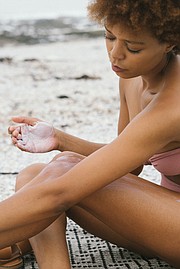By ALESHA CADET
Tribune Features Reporter
acadet@tribunemedia.net
Summer is in full swing. And after 14 months of varying lockdowns and restrictions, Bahamians are more than ready to embrace the great outdoors.
While fun and relaxation await us, there are also some dangers associated with spending more time outside that we should all be mindful of.
With the record-breaking temperatures all over the world over last few years, there are increasing concerns surrounding skin health and the sun’s harmful UV rays.
Dr Naiara Braghiroli, a dermatologist at the Miami Cancer Institute who specialises in skin cancer, has dedicated her career to research and the use of reflectance confocal microscopy for the diagnoses of different types of benign and malignant skin lesions.
Dr Braghiroli believes with the Bahamas being a tropical climate where people spend a lot of time outdoors, it is essential to know about sun safety, including the appropriate way to apply sunscreen and other protective measures, such as wearing a hat or UV protective clothing.
And she said it is during the summer months, particularly during the hours of 10am and4 pm that the sun's UV rays are at their most intense.
She advises everyone, regardless of skin colour, to wear sunscreen and a hat while outside, as well as be vigilant about moles and sores on your skin.
"If you see any new or changing sores, as well as nodules or scars that don't heal, it can be a potential sign of cancer," said Dr Braghiroli.
She recommends a product with an SPF of 30 or higher and to apply it at least 15 minutes before going outside and then reapplying at least every two hours.
“A general rule to check for suspicious legions are asymmetrical in shape; the border is not smooth, but rather jagged, raised, or appears irregular; if it begins to change colour, become darker or look uneven diameter, or if it grows in any way and an evolving appearance.
“Although many believe that Black people cannot get skin cancer, the possibility is present. While it is true that skin cancer is less prevalent in dark-skinned populations, anyone regardless of their skin colour or heritage can develop skin cancer, especially when they are exposed to UV rays from the sun or tanning beds for an extended period," she said.
Dr Braghiroli said genetics and family history can also play a part. For example, those with a family history of skin cancer should have their bodies examined by a healthcare professional annually. And when it comes to melanoma, one of the types of skin cancer, individuals who have three or more first-degree relatives diagnosed with melanoma are at a higher risk of developing it themselves.
Other risk factors include having many moles, more than 50, and scars from previous wounds. Additionally, individuals who have HPV, smoke, or are immunosuppressed, are also at greater risk for developing skin cancer.
“Skin cancer can also show up in places that are rarely, if ever, exposed to sunlight. These include areas between the toes, on the soles of the feet, in the eyes, known as ocular melanoma, and on genitalia," she said.






Comments
Use the comment form below to begin a discussion about this content.
Sign in to comment
Or login with:
OpenID